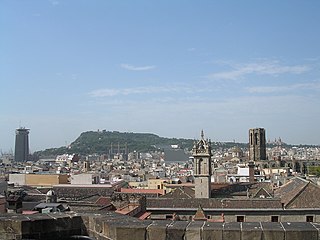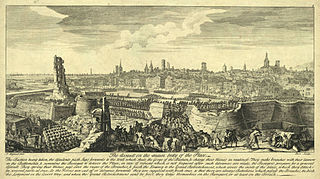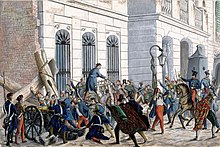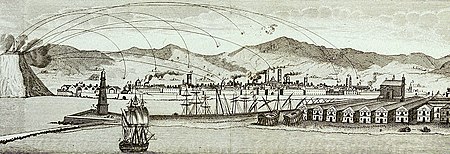
Montjuïc is a hill in Barcelona, Catalonia, Spain.

Isabella II was Queen of Spain from 1833 until her deposition in 1868. She is the only queen regnant in the history of unified Spain.
The Carlist Wars were a series of civil wars that took place in Spain during the 19th century. The contenders fought over claims to the throne, although some political differences also existed. Several times during the period from 1833 to 1876 the Carlists—followers of Don Carlos (1788–1855), an infante, and of his descendants—rallied to the cry of "God, Country, and King" and fought for the cause of Spanish tradition against liberalism, and later the republicanism, of the Spanish governments of the day. The Carlist Wars had a strong regional component, given that the new order called into question region–specific law arrangements and customs kept for centuries.

Maria Christina of the Two Sicilies was the queen consort of Spain from 1829 to 1833 and queen regent of the kingdom from 1833, when her daughter became queen at age two, to 1840. By virtue of her short marriage to King Ferdinand VII of Spain, she became a central character in Spanish history for nearly 50 years, thanks to introducing a bicameral model of government based on the Bourbon Restoration in France: the Spanish Royal Statute of 1834.

Baldomero Fernández-Espartero y Álvarez de Toro was a Spanish marshal and statesman. He served as the Regent of the Realm, three times as Prime Minister and briefly as President of the Congress of Deputies. Throughout his life, he was endowed with a long list of titles such as Prince of Vergara, Duke of la Victoria, Count of Luchana, Viscount of Banderas and was also styled as "the Peacemaker".

Spain in the 19th century was a country in turmoil. Occupied by Napoleon from 1808 to 1814, a massively destructive "liberation war" ensued. Following the Spanish Constitution of 1812, Spain was divided between the 1812 constitution's liberal principles and the absolutism personified by the rule of Ferdinand VII, who repealed the 1812 Constitution for the first time in 1814, only to be forced to swear over the constitution again in 1820 after a liberal pronunciamiento, giving way to the brief Trienio Liberal (1820–1823).

Francisco Serrano Domínguez, 1st Duke of la Torre, Grandee of Spain, Count of San Antonio was a Spanish marshal and statesman. He was Prime Minister of Spain in 1868–69 and regent in 1869–70.

Pascual Madoz Ibáñez was a Spanish politician and statistician.

The Third Carlist War, which occurred from 1872 to 1876, was the last Carlist War in Spain. It is sometimes referred to as the "Second Carlist War", as the earlier "Second" War (1847–1849) was smaller in scale and relatively trivial in political consequence.

The siege of Barcelona was a thirteen month battle at the end of the War of Spanish Succession, which pitted Archduke Charles of Austria against Philip V of Spain, backed by France in a contest for the Spanish crown.

Martín Zurbano Baras was a Spanish military figure. A guerrilla leader, he is considered a "martyr to Spanish liberty".
The National Militia in Spain was a citizen-organized quasi-military force comparable to the National Guard that arose in France during the French Revolution.
The Liberal Union was a political party in Spain in the third quarter of the 19th century. It was founded by Leopoldo O'Donnell in 1858 with the intent of forging a compromise and taking a centrist position between the two forces that had hitherto dominated Spanish politics during the reign of Isabella II. On one side were the forces of conservative liberalism known as the doceañistas, arrayed around the Moderate Party. Among their leading figures were the queen mother Maria Christina of the Two Sicilies and General Ramón María Narváez. On the other were radical liberal exaltados or veinteañistas arrayed around the Progressive Party and the National Militia. Among their leading figures was General Baldomero Espartero. Both parties had fought on the same side in the Carlist Wars, but they had also at times fought against one another, and elements of the Moderate Party leaned toward absolute monarchy themselves. O'Donnell's intent was to bring together the non-absolutist Moderates and the less "exalted" (radical) Progressives and to occupy the political center. He first came forward with this program in September 1854 a few months after the end of the 10-year reign of the Moderates, but did not succeed in forming a party at that time.

The July 1936 military uprising in Barcelona was a military uprising in Barcelona, the capital and largest city of Catalonia, Spain on 19 July 1936 which contributed to the start of the Spanish Civil War. Most of the Spanish Army officers in the city supported the coup, but the Civil Guard, the Assault Guard and the Mossos d'Esquadra remained loyal to the Republican government. Furthermore, Barcelona was one of the strongholds of the anarchist union, the Confederación Nacional del Trabajo (CNT). The rebel troops were defeated after one day of bloody combat.

The reign of Isabella II has been seen as being essential to the modern history of Spain. Isabella's reign spanned the death of Ferdinand VII in 1833 until the Spanish Glorious Revolution of 1868, which forced the Queen into exile and established a liberal state in Spain.

The following outline is provided as an overview of and topical guide to Barcelona:

Queen Isabella II of Spain was barely three years of age when her father, King Ferdinand VII, died on 29 September 1833. Her minority age was marked first by the regency of her mother, Maria Christina of the Two Sicilies, and then under General Baldomero Espartero, covering almost ten years of her reign, until 23 July 1843, when Isabella was declared to be of age.

The Citadel of Barcelona was a bastion fort citadel built in Barcelona. The works commenced in 1714 and, at the time of its construction, it was the largest fortress in Europe, capable of housing 8,000 troops.
The Barcelona Weavers Association was an association of weavers of cotton from Barcelona and neighboring towns. It was the first union in the labor movement in Spain.

















